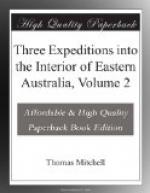We continued along the riverbank passing quawys of various names as they were pointed out by our guide. We crossed the skirt of an extensive plain (Eeoappa) which brought in view just ahead of us a low ridge named Wallangome. At 8 1/2 miles we found the river close under the southern extremity of this hill, and its rocks so obstructed our passage that we were delayed an hour in clearing a way. I ascended that point nearest the river and determined its position by taking angles on various heights already laid down in my map such as Granard, Yarrarar, Mount Torrens, etc. The hill itself consisted chiefly of quartz rock, but at its base were water-worn blocks of quartzose sandstone containing pebbles of quartz, and they seemed to be the principal rock in the bed of the Lachlan.
As we proceeded a low rocky ridge or extremity from Wallangome extended upwards of a mile along the river. Soon after we had passed a bend called Taralago we crossed the southern limits of a plain of which the local name is Nyaindurry, being bounded on the north-west by an isolated hill named Moriattu. After passing successively two similar points of the river we reached that of Gooda, where we encamped, the latitude observed being 33 degrees 23 minutes 3 seconds South.
WILD CATTLE.
Mr. Stapylton, with overseer Burnett and the natives, had gone forward early in the morning towards the hills near this place in pursuit of wild cattle, which were said to abound near it. The tracks we perceived were old, and although the other party had found many that were newer they returned without having seen any of these wild animals. It appeared that a herd of such cattle had got together about Macquarie’s range, then only a short way ahead of us, and I saw no objections to the overseer’s killing one or two, as he wished to do, in order that we might feed our native guides without drawing so largely as we were otherwise compelled to do on our own stock of provisions. This was a fortunate day for us in regard to plants. Besides several curious kinds of grass,* a splendid blue Brunonia was found on Wallangome. Its colour surpassed any azure I had ever seen in flowers, the tinge being rather deeper than that of the turquoise. We also obtained the seed so that I hoped this plant, which seemed hardy enough, might become a pleasing addition to our horticultural treasures.
The flowers are nature’s jewels.**
(Footnote. Lappago racemosa, W. and Aristida ramosa, R. Br.)
(**Footnote. Croly’s Gems.)
The pink lily* was also found, as on Yerrarar, amongst rocks, but growing in rich red soil. We gathered a number of the bulbs, being very desirous to propagate this plant, which differs from the common white amaryllis and others belonging to the plains not only in colour, but also in the absence from their corona of intermediate teeth. We again found here the new Xerotes, having the flower in five or six round tufts on the blade. The flowered blades drooped around, radiating from the centre, while those without flowers stood upright, giving to the whole an uncommon appearance; the flower had a very pleasant perfume.




